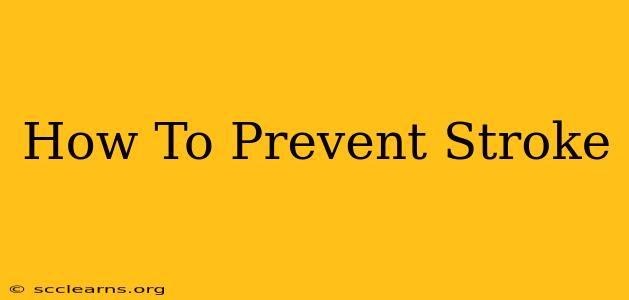A stroke, also known as a cerebrovascular accident (CVA), occurs when the blood supply to part of your brain is interrupted or reduced, preventing brain tissue from getting the oxygen and nutrients it needs. This can lead to permanent brain damage, disability, or even death. However, understanding the risk factors and adopting preventative measures can significantly reduce your chances of experiencing a stroke. This comprehensive guide will equip you with the knowledge and strategies to protect your brain health.
Understanding Stroke Risk Factors
Before diving into prevention strategies, it's crucial to understand the factors that increase your risk of stroke. These risk factors are broadly categorized into modifiable (those you can change) and non-modifiable (those you cannot).
Modifiable Risk Factors:
- High Blood Pressure (Hypertension): This is the single most important risk factor for stroke. Regularly monitoring and managing your blood pressure through lifestyle changes and/or medication is essential.
- High Cholesterol: Elevated cholesterol levels contribute to the buildup of plaque in your arteries, increasing your risk of stroke. A healthy diet and regular exercise can help lower cholesterol.
- Smoking: Smoking significantly increases your risk of stroke by damaging blood vessels and increasing blood clotting. Quitting smoking is one of the most impactful things you can do to protect your health.
- Diabetes: Diabetes damages blood vessels and increases the risk of blood clots, making you more susceptible to stroke. Careful management of blood sugar levels is crucial.
- Physical Inactivity: A sedentary lifestyle increases your risk of several health problems, including stroke. Regular physical activity strengthens your heart and improves circulation.
- Obesity: Being overweight or obese increases your risk of many health conditions, including stroke. Maintaining a healthy weight through diet and exercise is essential.
- Unhealthy Diet: A diet high in saturated and trans fats, sodium, and cholesterol can contribute to high blood pressure and high cholesterol, increasing your stroke risk. A balanced diet rich in fruits, vegetables, and whole grains is recommended.
- Atrial Fibrillation: This irregular heartbeat increases the risk of blood clots forming in the heart, which can travel to the brain and cause a stroke. Treatment options are available to manage atrial fibrillation.
- Excessive Alcohol Consumption: Heavy drinking increases your blood pressure and risk of stroke. Moderate alcohol consumption, if any, is recommended.
- Stress: Chronic stress can negatively impact your cardiovascular health, increasing your risk of stroke. Practicing stress-management techniques is important.
- Drug Use: Illicit drug use can significantly increase your risk of stroke.
Non-Modifiable Risk Factors:
- Age: The risk of stroke increases significantly with age.
- Family History: Having a family history of stroke increases your risk.
- Race: Certain racial groups, such as African Americans, have a higher risk of stroke.
- Sex: Men are slightly more likely to have a stroke than women.
Preventing Stroke: Practical Steps You Can Take
Now that you understand the risk factors, let's explore practical steps to prevent a stroke:
Lifestyle Modifications:
- Adopt a Heart-Healthy Diet: Focus on fruits, vegetables, whole grains, lean proteins, and healthy fats. Limit saturated and trans fats, sodium, and added sugars.
- Regular Exercise: Aim for at least 150 minutes of moderate-intensity aerobic activity or 75 minutes of vigorous-intensity aerobic activity per week. Include strength training exercises twice a week.
- Maintain a Healthy Weight: Achieve and maintain a healthy body mass index (BMI).
- Quit Smoking: Seek support and resources to help you quit smoking.
- Manage Stress: Practice relaxation techniques like yoga, meditation, or deep breathing exercises.
- Limit Alcohol Consumption: Follow recommended guidelines for alcohol consumption.
Medical Management:
- Regular Checkups: Schedule regular checkups with your doctor to monitor your blood pressure, cholesterol, and blood sugar levels.
- Medication: If you have high blood pressure, high cholesterol, diabetes, or atrial fibrillation, take your prescribed medications as directed.
Recognizing Stroke Symptoms: Act FAST
Recognizing the symptoms of a stroke is crucial for prompt treatment. Use the FAST acronym:
- Face drooping: Does one side of the face droop?
- Arm weakness: Is one arm weak or numb?
- Speech difficulty: Is speech slurred or difficult to understand?
- Time to call 911: If you observe any of these signs, call emergency services immediately.
Early intervention is key in stroke treatment. The faster you receive medical care, the better the chances of minimizing long-term damage.
Conclusion: Taking Control of Your Stroke Risk
Preventing a stroke requires a proactive approach that involves understanding your risk factors, making healthy lifestyle choices, and seeking appropriate medical care. By implementing the strategies outlined in this guide, you can significantly reduce your risk and protect your brain health for years to come. Remember, your health is your greatest asset – invest in it wisely.

